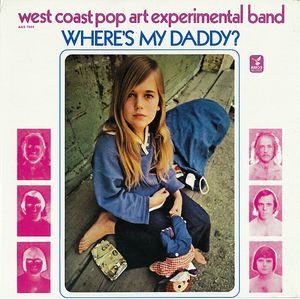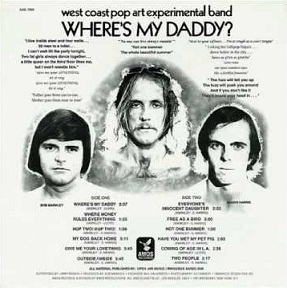The Atrocious Music Collection: #15 in a series
Artist: The West Coast Pop Art Experimental Band (1965-1970)
Album Title: Where's My Daddy
Category: Obscure BandsYear: 1969
Cover art style: Disturbingly suggestive
Audio samples: Not One Bummer, Give Me Your Love Thing
Acquisition: Airport Plaza record store, Hazlet, NJ


Click on pictures for full-sized images
There’s no doubt that the album cover is the thing that gets your attention. The slightly disturbing title combines suggestively with the our subject, who appears to be a homeless waif. But the pièce de résistance is the appearance of the band members, shirtless, in both positive and negative image on either side of her. Band members Dan Harris, Shawn Harris, and Bob Markley are not necessarily un-handsome, but they are not quite…let’s just say “father-figures.”
Which further suggests the title Where’s My Daddy? was not a question one of these gents was going to answer with the Darth Vader line, “I am your father.” But more on that later.
If the cover was enough to make one pick up the album, turning it around to the back would seal the deal. There are bits of lyrics from some of the songs, a small promise of what awaits you. After reading these, how could you not give into your curiosity about what the songs sound like? Although the lyric-tease would work as a marketing tool for some recordings, I’m not sure this was a great idea with this record, released in 1969, a year that also saw the release of Abbey Road, Tommy, and Everybody Knows This Is Nowhere, to name three records with pretty good lyrics.
The first lyrical excerpt includes the word “toilet” in the second line, and we can hopefully all agree that “toilet” is not, in nearly all cases, a word we really want to hear sung. Another example: the observation “Father goes from can to can/Mother goes from man to man” is perhaps not as deep as the band thinks it is. It may still be true that “The fuzz will feel you up/The fuzz will push you around/And if you don’t like it/They’ll knock your head in,” but I think there’s a rhyme missing in there.
My personal favorite, really one of the best worst-rhymes out there, is “Not one bummer/the whole beautiful summer.” The band certainly liked it a lot – it’s sung through nearly half of the song Not One Bummer.
Moving on to their sound, there seems to exist some confusion about what kind of music this band produces. There are moments of California-easy-folk rock (My Dog Back Home), war protest songs (Hup Two! Hup Two!) and Zappa-esque bits that live up to the “experimental” part of their name. The band actually got pretty far out covering Zappa’s Help I’m a Rock on their 1967 album Part One, not to be confused with their 1966 album Volume One. For the record, there is a Vol. 2 and Vol. 3, but no Part Two.
Some of the tracks – heck, most of them – barely contain enough material to be songs. There’s an unfinished quality here that borders on suggestive. Severely limited studio time? Absenteeism amongst the band members? An inability to finish writing the tunes? Just a lack of good taste? Drugs?
My overall impression was, “How did this album get made?”
When I got the record, I knew nothing about the WCPAEB. Remember, this was pre-internet times. That state of ignorance continued until I did some digging in preparation to write this some 25 years later. I almost wish I hadn’t bothered.
Where’s My Daddy was WCPAEB’s fifth album of a total of six. It was also their first indy release after their label dropped them. In other words, this was just about the end of the line for them. This is a band in a tailspin, which may be the best explanation why so much of this sounds unfinished.
But it’s particularly disturbing to read that the album might have been “a clear reflection of Markley's growing personal problems (including several recent arrests for indecent acts with underage females). The LP was apparently intended as a concept piece with a plotline having to do with the life of a ten year old female runaway” (http://badcatrecords.com/BadCat/WESTcoastPOP.htm).
So my initial impression of the cover, which was that there is no way this is meant to signify what it seems to be pretty clearly signifying, was likely off. It appears they knew exactly what this set of images suggested, which makes it doubly disturbing.
It kind of takes the fun out of listening to it, perhaps proving once again that in gaining knowledge we lose innocence.
